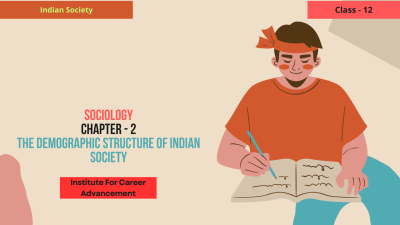Course description
The Class 12 Sociology chapter on "Social Movements" focuses on the various types, causes, and effects of collective social actions that aim to bring about change or resist change in society. Social movements are seen as key instruments in transforming social structures and influencing policies. Here's an overview of the key concepts and topics covered in this chapter:
1. Introduction to Social Movements
Definition of social movements: Organized efforts by a large group of people to achieve a common goal, typically related to social or political change.
Characteristics of social movements: collective action, shared objectives, sustained efforts, and challenges to established norms or systems.
The role of social movements in democratization, justice, and equality.
2. Types of Social Movements
Revolutionary Movements: Seek radical and fundamental changes in society, often aiming to overthrow an existing system (e.g., French Revolution, Russian Revolution).
Reformist Movements: Aim for gradual change within the existing system without overturning it (e.g., Civil Rights Movement, women's suffrage).
Redemptive Movements: Focus on personal or spiritual change (e.g., religious movements or movements for sobriety).
Alternative Movements: Target small-scale change within individuals, such as lifestyle choices (e.g., environmental movements encouraging sustainable living).
Resistance Movements: Organized to resist or oppose specific social changes (e.g., movements against globalization or against government policies).
3. Causes and Factors Leading to Social Movements
Social, political, and economic factors that contribute to the rise of social movements.
Grievances and inequalities as motivating factors: poverty, unemployment, discrimination, environmental degradation, political oppression, etc.
The role of ideology in shaping the goals and direction of social movements.
The influence of globalization, technology, and social media in the rise of modern movements.
4. Stages of Social Movements
Emergence: Initial phase where people become aware of an issue and begin organizing.
Coalescence: The movement gains momentum and visibility, with increased participation and more organized activities.
Bureaucratization: The movement becomes institutionalized, with formal leadership and strategies for sustained actions.
Decline: The movement either achieves its goals, loses momentum, or faces repression, leading to its eventual decline.
5. Strategies and Tactics in Social Movements
Peaceful protests: Demonstrations, marches, sit-ins, and civil disobedience (e.g., Gandhi's non-violent resistance, Martin Luther King Jr.'s activism).
Direct action: Strikes, boycotts, and disruptions to challenge the status quo.
Use of social media and digital platforms to spread awareness, organize events, and mobilize support (e.g., #MeToo, Black Lives Matter).
Formation of alliances with other groups, political parties, or international organizations for greater impact.
6. Social Movements in India
Nationalist Movements: The Indian independence struggle, including the Non-Cooperation, Civil Disobedience, and Quit India Movements.
Peasant Movements: Movements like the Tebhaga Movement, Telangana Movement, and the Green Revolution protests aimed at addressing agricultural issues.
Workers' Movements: Industrial strikes and trade union movements advocating for labor rights, fair wages, and better working conditions.
Dalit Movements: Efforts to end caste-based discrimination and promote social justice for Dalits, including the Dalit Panthers and the Bahujan Samaj Party.
Environmental Movements: Movements like Chipko, Narmada Bachao Andolan, and contemporary movements focusing on sustainability and indigenous rights.
7. New Social Movements
Characteristics of new social movements: Focus on identity, rights, and lifestyle issues rather than class-based or economic struggles (e.g., LGBTQ+ rights, feminist movements, environmentalism).
These movements emphasize decentralization and reject traditional hierarchical structures.
Examples include movements for gender equality, human rights, environmental justice, and anti-globalization campaigns.
8. Role of Leadership and Organization in Social Movements
Importance of charismatic leaders in mobilizing people and articulating the goals of the movement (e.g., Mahatma Gandhi, Martin Luther King Jr., Nelson Mandela).
The role of grassroots organizations in coordinating and sustaining movements.
Challenges faced by leaders in maintaining unity, managing resources, and dealing with opposition.
9. Impact of Social Movements
Social and political change: How movements lead to policy changes, legal reforms, and shifts in public opinion.
The long-term effects of movements on institutions (e.g., labor laws, gender rights, environmental regulations).
The role of movements in empowering marginalized groups and reshaping power dynamics in society.
"সামাজিক আন্দোলন"-এর উপর দ্বাদশ শ্রেণির সমাজবিজ্ঞান অধ্যায়টি সমাজে পরিবর্তন আনতে বা প্রতিরোধ করার লক্ষ্যে সম্মিলিত সামাজিক ক্রিয়াকলাপের বিভিন্ন প্রকার, কারণ এবং প্রভাবের উপর দৃষ্টি নিবদ্ধ করে। সামাজিক কাঠামো পরিবর্তন এবং নীতিগুলিকে প্রভাবিত করার মূল হাতিয়ার হিসাবে সামাজিক আন্দোলনগুলিকে দেখা হয়। এই অধ্যায়ে অন্তর্ভুক্ত মূল ধারণাগুলি এবং বিষয়গুলির একটি সংক্ষিপ্ত বিবরণ এখানে দেওয়া হলঃ
1টি। সামাজিক আন্দোলনের পরিচিতি
সামাজিক আন্দোলনের সংজ্ঞাঃ সাধারণত সামাজিক বা রাজনৈতিক পরিবর্তনের সাথে সম্পর্কিত একটি সাধারণ লক্ষ্য অর্জনের জন্য জনগণের একটি বড় গোষ্ঠীর দ্বারা সংগঠিত প্রচেষ্টা।
সামাজিক আন্দোলনের বৈশিষ্ট্যঃ সম্মিলিত কর্ম, যৌথ উদ্দেশ্য, টেকসই প্রচেষ্টা এবং প্রতিষ্ঠিত নিয়ম বা ব্যবস্থার প্রতি চ্যালেঞ্জ।
গণতন্ত্রীকরণ, ন্যায়বিচার ও সমতায় সামাজিক আন্দোলনের ভূমিকা।
2. সামাজিক আন্দোলনের প্রকার
বিপ্লবী আন্দোলনঃ সমাজে আমূল ও মৌলিক পরিবর্তন চান, প্রায়শই বিদ্যমান ব্যবস্থাকে উৎখাত করার লক্ষ্য রাখেন। (e.g., French Revolution, Russian Revolution).
সংস্কারবাদী আন্দোলনঃ এটিকে বাতিল না করে বিদ্যমান ব্যবস্থার মধ্যে ধীরে ধীরে পরিবর্তনের লক্ষ্য (e.g., নাগরিক অধিকার আন্দোলন, মহিলাদের ভোটাধিকার)
উদ্ধারমূলক আন্দোলনঃ ব্যক্তিগত বা আধ্যাত্মিক পরিবর্তনের দিকে মনোনিবেশ করুন। (e.g., religious movements or movements for sobriety).
বিকল্প আন্দোলনঃ ব্যক্তিদের মধ্যে ছোট আকারের পরিবর্তন লক্ষ্য করুন, যেমন জীবনধারা পছন্দ (e.g., environmental movements encouraging sustainable living).
প্রতিরোধ আন্দোলনঃ নির্দিষ্ট সামাজিক পরিবর্তন প্রতিরোধ বা বিরোধিতা করার জন্য সংগঠিত (e.g., movements against globalization or against government policies).
3. কারণ ও কারণ সামাজিক আন্দোলনের দিকে পরিচালিত করা
সামাজিক, রাজনৈতিক এবং অর্থনৈতিক কারণগুলি সামাজিক আন্দোলনের উত্থানে অবদান রাখে।
উদ্দীপনার কারণ হিসাবে অভিযোগ ও বৈষম্যঃ দারিদ্র্য, বেকারত্ব, বৈষম্য, পরিবেশের অবনতি, রাজনৈতিক নিপীড়ন ইত্যাদি।
সামাজিক আন্দোলনের লক্ষ্য ও দিক নির্ধারণে মতাদর্শের ভূমিকা।
আধুনিক আন্দোলনের উত্থানে বিশ্বায়ন, প্রযুক্তি এবং সামাজিক মাধ্যমের প্রভাব।
4. সামাজিক আন্দোলনের পর্যায়সমূহ
উত্থানঃ প্রাথমিক পর্যায় যেখানে মানুষ কোনও সমস্যা সম্পর্কে সচেতন হয় এবং সংগঠিত হতে শুরু করে।
সংহতকরণঃ বর্ধিত অংশগ্রহণ এবং আরও সংগঠিত ক্রিয়াকলাপের সাথে আন্দোলন গতি এবং দৃশ্যমানতা অর্জন করে।
আমলাতান্ত্রিককরণঃ স্থায়ী পদক্ষেপের জন্য আনুষ্ঠানিক নেতৃত্ব এবং কৌশল সহ আন্দোলনটি প্রাতিষ্ঠানিক হয়ে ওঠে।
পতনঃ আন্দোলনটি হয় তার লক্ষ্য অর্জন করে, গতি হারায়, অথবা দমন-পীড়নের সম্মুখীন হয়, যার ফলে এর চূড়ান্ত পতন ঘটে।
5. সামাজিক আন্দোলনে কৌশল ও কৌশল
শান্তিপূর্ণ প্রতিবাদঃ বিক্ষোভ, মিছিল, অবস্থান ধর্মঘট এবং আইন অমান্য (e.g., গান্ধীর অহিংস প্রতিরোধ, মার্টিন লুথার কিং জুনিয়রের সক্রিয়তা)
প্রত্যক্ষ পদক্ষেপঃ স্থিতাবস্থাকে চ্যালেঞ্জ জানাতে ধর্মঘট, বয়কট এবং বিঘ্ন।
সচেতনতা ছড়িয়ে দিতে, ইভেন্টগুলি সংগঠিত করতে এবং সমর্থন জড়ো করতে সামাজিক মিডিয়া এবং ডিজিটাল প্ল্যাটফর্মগুলির ব্যবহার (e.g., #MeToo, ব্ল্যাক লাইভস ম্যাটার)
বৃহত্তর প্রভাবের জন্য অন্যান্য গোষ্ঠী, রাজনৈতিক দল বা আন্তর্জাতিক সংস্থার সঙ্গে জোট গঠন।
6টি। ভারতে সামাজিক আন্দোলন
জাতীয়তাবাদী আন্দোলনঃ অসহযোগ, আইন অমান্য এবং ভারত ছাড়ো আন্দোলন সহ ভারতীয় স্বাধীনতা সংগ্রাম।
কৃষক আন্দোলনঃ তেভাগা আন্দোলন, তেলেঙ্গানা আন্দোলন এবং সবুজ বিপ্লবের বিক্ষোভের মতো আন্দোলনগুলির লক্ষ্য ছিল কৃষি সংক্রান্ত সমস্যাগুলির সমাধান করা।
শ্রমিক আন্দোলনঃ শ্রম অধিকার, ন্যায্য মজুরি এবং আরও ভাল কাজের অবস্থার পক্ষে শিল্প ধর্মঘট এবং ট্রেড ইউনিয়ন আন্দোলন।
দলিত আন্দোলনঃ দলিত প্যান্থার্স এবং বহুজন সমাজ পার্টি সহ দলিতদের জন্য বর্ণ-ভিত্তিক বৈষম্যের অবসান এবং সামাজিক ন্যায়বিচার প্রচারের প্রচেষ্টা।
পরিবেশ আন্দোলনঃ চিপকো, নর্মদা বাঁচাও আন্দোলন এবং স্থায়িত্ব ও আদিবাসী অধিকারের উপর দৃষ্টি নিবদ্ধ করে সমসাময়িক আন্দোলন।
7. নতুন সামাজিক আন্দোলন
নতুন সামাজিক আন্দোলনের বৈশিষ্ট্যঃ শ্রেণী-ভিত্তিক বা অর্থনৈতিক সংগ্রামের পরিবর্তে পরিচয়, অধিকার এবং জীবনযাত্রার বিষয়গুলিতে ফোকাস করুন (e.g., LGBTQ + অধিকার, নারীবাদী আন্দোলন, পরিবেশবাদ)
এই আন্দোলনগুলি বিকেন্দ্রীকরণের উপর জোর দেয় এবং ঐতিহ্যবাহী শ্রেণিবদ্ধ কাঠামোকে প্রত্যাখ্যান করে।
উদাহরণের মধ্যে রয়েছে লিঙ্গ সমতা আন্দোলন, মানবাধিকার, পরিবেশগত ন্যায়বিচার এবং বিশ্বায়ন বিরোধী প্রচারণা।
8. সামাজিক আন্দোলনে নেতৃত্ব ও সংগঠনের ভূমিকা
জনগণকে সংগঠিত করতে এবং আন্দোলনের লক্ষ্যগুলি স্পষ্ট করতে ক্যারিশম্যাটিক নেতাদের গুরুত্ব (e.g., Mahatma Gandhi, Martin Luther King Jr., Nelson Mandela).
আন্দোলনের সমন্বয় ও টেকসইকরণে তৃণমূল সংগঠনগুলির ভূমিকা।
ঐক্য বজায় রাখা, সম্পদ পরিচালনা এবং বিরোধীদের মোকাবিলা করার ক্ষেত্রে নেতাদের সম্মুখীন হওয়া চ্যালেঞ্জ।
9টি। সামাজিক আন্দোলনের প্রভাব
সামাজিক ও রাজনৈতিক পরিবর্তনঃ আন্দোলন কীভাবে নীতিগত পরিবর্তন, আইনি সংস্কার এবং জনমতের পরিবর্তনের দিকে পরিচালিত করে।
প্রতিষ্ঠানের উপর আন্দোলনের দীর্ঘমেয়াদী প্রভাব (e.g., labor laws, gender rights, environmental regulations).
প্রান্তিক গোষ্ঠীগুলির ক্ষমতায়নে এবং সমাজে ক্ষমতার গতিশীলতাকে নতুন আকার দেওয়ার ক্ষেত্রে আন্দোলনের ভূমিকা।



















